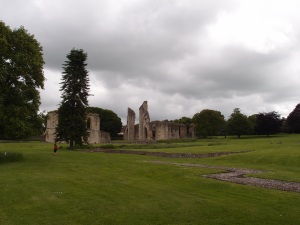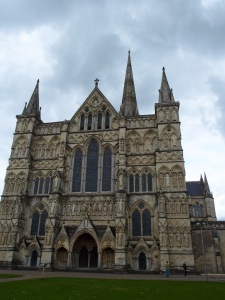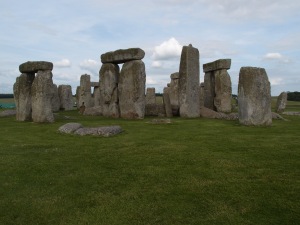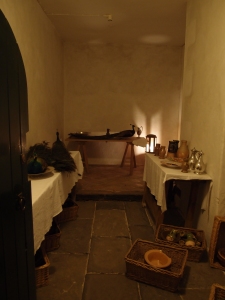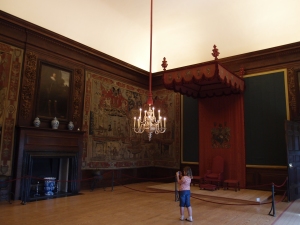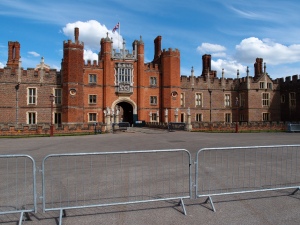The next morning we woke early and had a lovely breakfast in the tea room of East Lee. The dining room is delightfully Victorian, quaint, and adorable. I decided to mix it up and had waffles that morning. The syrup they were served with was more honey-like than maple, so they were just a bit sweet for me, but overall everything was excellent. We had planned to spend an hour or so that morning visiting the Roman Painted House in Dover, which is a small museum where you can see the excavation of a small Roman-era domicile. Unfortunately, the site was closed for an undisclosed reason. So instead, we got an early start towards Canterbury.
The drive to Canterbury was not far and we ended up parking at the town car park just outside the city and taking the bus into the heart of the town. This method of traffic control is starting to be practiced or just about to be put into place in many towns across England, and it’s a great alternative to having to navigate the super small medieval streets with so many cars.
I really enjoyed what little we saw of downtown Canterbury and would love to return and spend more time there some day. For this trip, we concentrated mostly on just visiting the cathedral. Canterbury Cathedral is the seat of the Archbishop of Canterbury and has been attracting pilgrims and legends for hundreds of years. It holds the tombs of King Henry IV and St. Thomas a Becket. The chapel in which St. Thomas a Becket was murdered in 1170 was so famous for its pilgrims in the Middle Ages that it was incorporated into a little-known novel you may not have heard of, something called The Canterbury Tales by someone named Geoffrey Chaucer? I kid, of course. I only remember reading this in high school and hating it, but I would never hold that against the town!
There are many interesting tombs and chapels to visit while there. Again the audio guide is complete and helpful in understanding the history of the church and the many interesting tidbits about the church and the people involved with it. Below are a few photos from the cathedral.
After grabbing a sandwich for the road, we headed back to the car park, picked up the car, and started out for the city of Bath. Bath is located on the opposite side of England, but luckily, England is a small island so you can drive across it in just a few hours. We arrived in Bath in the early evening and found our B&B for the next couple of nights, Hill House. We really enjoyed our stay at Hill House. The owners are very accommodating and pleasant. Breakfast included everything you could ask for and our room was lovely. This was one of my favorite B&Bs that we stayed in this trip. We were on the top floor and had a great view of part of the city out the windows. I will say, I was surprised to learn just how hilly and how large Bath was. It’s sprawl is enormous, and it’s situated along rather steep hills in and around the city center. Having checked in, we headed out to do a little exploring and to find dinner. We ended up having a pleasant walk around the new town and seeing the Royal Crescent, a row of townhouses built in the 1700s. For dinner, we wandered down a small street to find Rustico Bistro, a small Italian restaurant. Dinner was fabulous! As the place was owned and run by Italians, the food was just as good as we had in Italy. We shared a bottle of wine and dined al fresco while I enjoyed some buffalo mozzarella potato gnocchi. I don’t recall what the Husband had, but I do remember that he was super excited that there was housemade limoncello available. It just doesn’t get any better than that! After dinner, we took the long, uphill walk back to the B&B to rest up for a day of sightseeing in the area around Bath itself.
The following morning after a delicious breakfast where we chatted with an Australian couple ending their six-week tour of Britain (Americans need better vacation time, guys!), we headed off in the car to see Glastonbury Abbey. The ruins of Glastonbury Abbey stand in the center of the sleepy town of Glastonbury in Somerset. The Abbey church and its monastery were large and powerful from the time of their building in the middle ages., but like most religious sites, the area on which the Abbey was built had a much longer and storied history with the original Saxon church having been built there in the 8th century. The Abbey would later fall into ruin after the dissolution of the monasteries by Henry VIII and stands today a shell of its former self and its lost grandeur. We visited several ruined abbeys, cathedrals, and churches on this trip, and this was truly one of my favorites. The air of this place was just filled with all of the mystery, legend, and history that this ground held. Just one of Glastonbury’s claims to fame is being the burial place of King Arthur (of Round Table, Guinevere, and Grail lore fame). The area is a large park and you can visit what has been excavated and what still stands of the church itself along with the buildings where the abbot and monks lived and worked. Seeing what remains of the site is moving and leaves you with just a small piece of what this once great abbey must have looked like when it stood mighty and proud. Below are a few pictures from the area.
With Glastonbury done, we headed off next to the small town of Salisbury to see the cathedral, home to England’s tallest spire (which can be climbed from the inside, ask me how I know). I had visited Salisbury Cathedral years ago on our school trip as part of our Salisbury/Stonehenge day trip, and when I saw that they give tower tours up the tower, I know the Husband would love to visit. Myself, I have issues with both heights and enclosed spaces, so these are not usually my thing, but I do try to do them from time to time for the experience and views. The Cathedral is worth a visit if you are in the area and if you don’t have a problem with heights, I do recommend the tower tour as it is both informative and you do get to walk all the way down the nave of the church, above the ceiling, so there’s that. Fun fact: the cathedral does contain the world’s oldest working modern clock, ticking away since 1386. Below are a few pics from the Cathedral.
After seeing the cathedral, we made our way across Salisbury Plain to perhaps the most famous prehistoric monument in the world, Stonehenge. The site is the proud new owner of a brand new visitors’ center, but not that much has really changed in the last 4,500 years. Many people are underwhelmed by Stonehenge, but I do think that it’s worth a visit when you’re in England. It’s just one of those sites that everyone should be able to say that they have seen!
Checking Stonehenge off the list, we headed out to one last spot for the day, Avebury. I was very interested in visiting Avebury which is basically another Stonehenge, but less touristy. It’s about the same age as Stonehenge, but much larger, containing the largest stone circle in Europe. And you can walk amongst the stones, which is something you can’t do at Stonehenge anymore. Unfortunately, while Avebury’s visitor information claims the site is open until dusk, that isn’t true and we only got a cursory few glances as we drove by some of the area. This was disappointing, but something to be saved for the next trip! Despite that disappointing end to the day, we headed back to Bath and grabbed dinner at a local pub before heading off to bed.
After breakfast the following morning, we headed into Bath’s center to see some of the city’s attractions. The historic area is very compact and also extremely crowded during the daylight hours. We started with a brief trip to Bath Abbey. I was slightly underwhelmed with Bath Abbey in both its size and decor, but the Husband did climb the tower there and seemed to enjoy doing that. While he was climbing the tower, I headed out into the town square to listen to some musicians and wander through a few shops. Once he had finished up, we headed just across the street to the Roman Baths, one of the best preserved Roman-era sites in Britain. The bath ruins really are quite extensive and worth a visit while in the area. Be forewarned, however, that it’s a popular site and thus incredibly crowded. Once we had toured the baths, we grabbed some pizza from The Real Italian Pizza Company and some gelato from its sister cafe, The Real Italian Ice Cream Company. Both were delicious. One nice thing about England? It’s close enough to continental Europe to attract Italian immigrants who run great restaurants! Fueled for more adventures, we collected our car and headed out towards the Cotswolds. Stay tuned to hear more about our adventures walking with sheep and sleeping above taverns!













